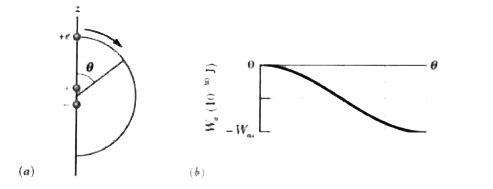In Fig. 24−65a, a particle of elementary charge +e is initially at coordinate −z=20 nm on the dipole axis (here a z axis) through an electric dipole, on the positive side of the dipole. (The origin of z is at the center of the dipole.) The particle is then moved along a circular path around the dipole center until it is at coordinate z=−20 nm, on the negative side of the dipole axis. Figure 24-37b gives the work W. done by the force moving the particle versus the angle θ that locates the particle relative to the positive direction of the z axis. The scale of the vertical axis is set by Was=2.0×10−30 J. What is the magnitude of the dipole moment?

2.8×10−37C.m
Topper's Solved these Questions
- ELECTRIC POTENTIALBOOK - RESNICK AND HALLIDAYCHAPTER - ELECTRIC POTENTIALEXERCISE - (PRACTICE QUESTIONS) Single Correct Choice Type
21 Videos
- ELECTRIC POTENTIALBOOK - RESNICK AND HALLIDAYCHAPTER - ELECTRIC POTENTIALEXERCISE - (PRACTICE QUESTIONS) More than One Correct Choice Type
8 Videos
- ELECTRIC POTENTIALBOOK - RESNICK AND HALLIDAYCHAPTER - ELECTRIC POTENTIALEXERCISE - CHECKPOINT
6 Videos
- ELECTRIC CHARGES AND FIELDSBOOK - RESNICK AND HALLIDAYCHAPTER - ELECTRIC CHARGES AND FIELDSEXERCISE - Practice Questions (Integer Type )
3 Videos
- ELECTROMAGNETIC INDUCTIONBOOK - RESNICK AND HALLIDAYCHAPTER - ELECTROMAGNETIC INDUCTIONEXERCISE - PRACTICE QUESTIONS (Integer Type)
14 Videos
Similar Questions
An electric dipole is kept on the axis of a uniformly charged ring at distance from the centre of the ring. The direction of the dipole moment is along the axis. The dipole moment is p, charge of the ring is Q & radius of the ring is R. The force on the dipole is
View SolutionAn electric dipole is placed along x-axis with its centre at origin:
View Solution
Knowledge Check
The electric field of an electric dipole at a point on its axis , at a distance d from the center of the dipole, varies as
A1dB1d2C1d3D1d32An electric dipole is kept on the axis of a uniformly charged ring at distance d from the centre of the ring. The direction of the dipole moment is along the axis. The dipole moment is p, charge of the ring is Q & radius of the ring is R. The force on the dipole is
ApQ3πε0√3R2B4pQ3πε0√3R2CpQ3πε0R2DzeroElectric field intensity (E) due to an electric dipole varies with distance (r ) from the point of the center of dipole as :
AE∝1rBE∝1r4CE∝1r2DE∝1r3
Electric field intensity (E) due to an electric dipole varies with distance (r ) from the point of the center of dipole as :
View SolutionElectric field intensity (E) due to an electric dipole varies with distance (r) of the point from the center of dipole as :
View SolutionElectric field intensity (E) due to an electric dipole varies with distance (r) from the point of the center of dipole as :
View SolutionAn electric dipole is placed along x-axis with its centre at origin:
View SolutionAt a point on the axis of an electric dipole
View Solution
